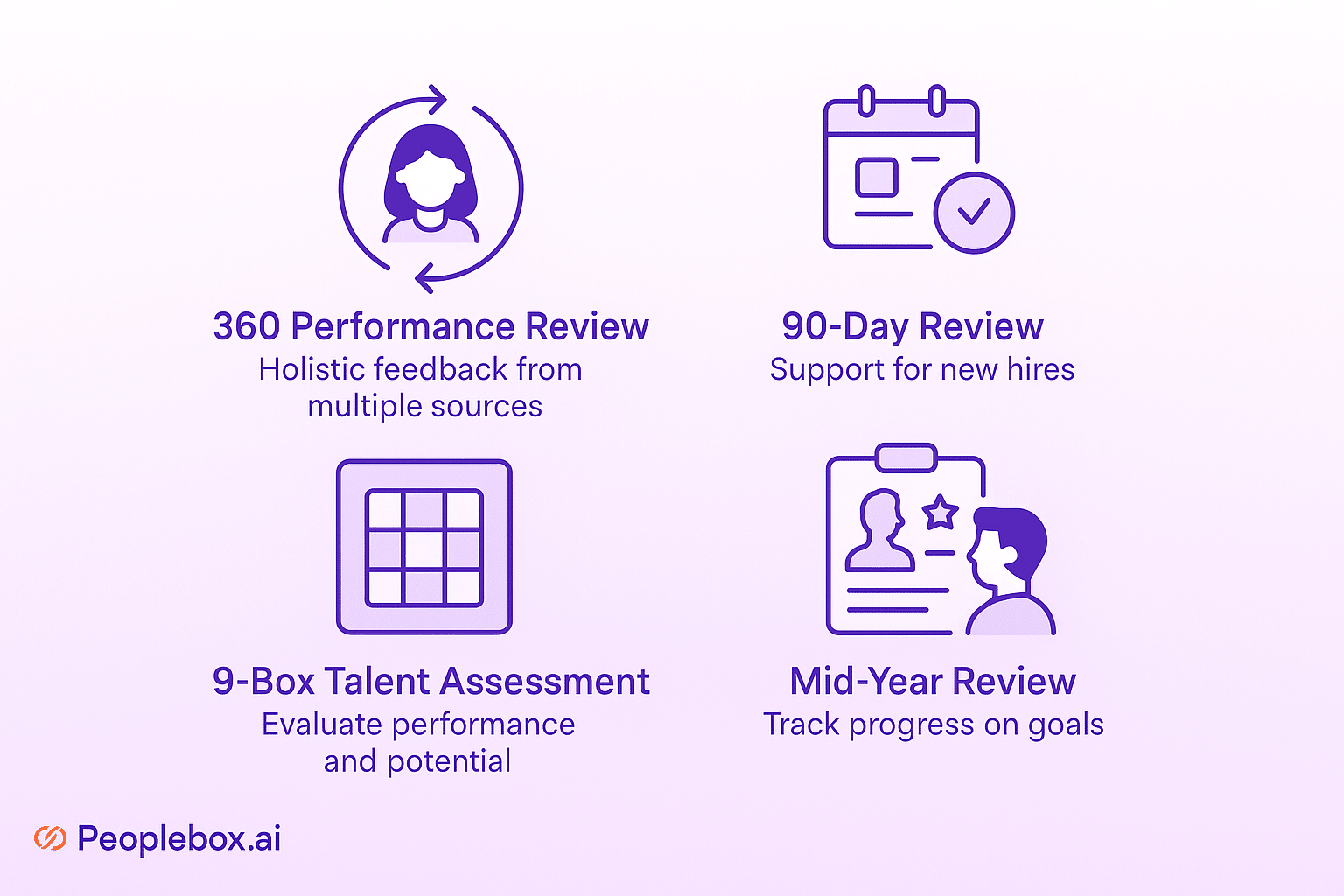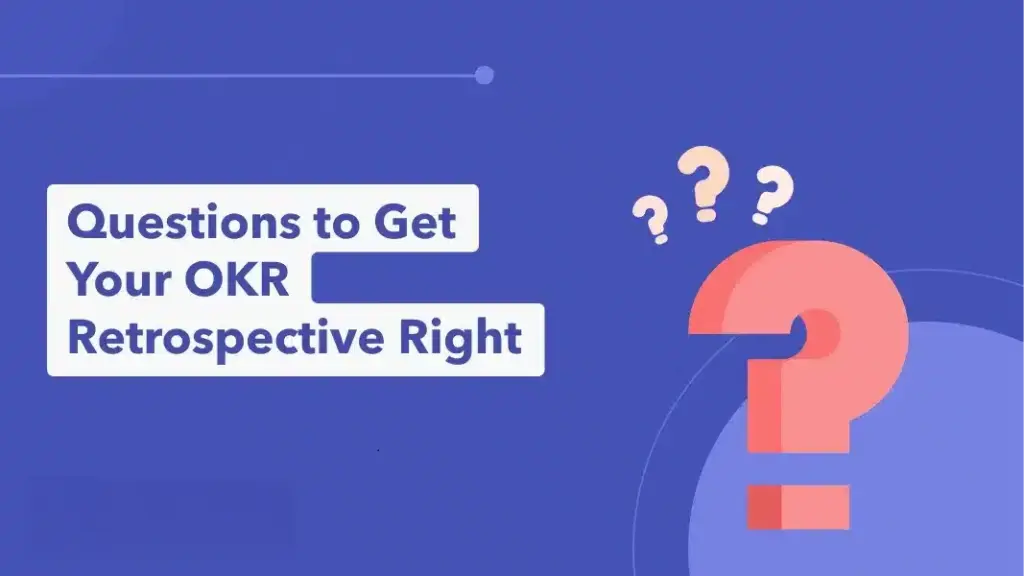TL;DR
Performance reviews often fail because they’re too generic, infrequent, or inconsistent. The solution isn’t more reviews, it’s smarter ones. From 360-degree feedback to quarterly reviews and self-evaluations, these 11 approaches help HR leaders build alignment, support employee growth, and boost retention.
Performance reviews are key to managing people and achieving success as a company. They give HR and managers chances to see how well people are doing, set real goals, and give feedback that helps individuals and the whole team get better.
When done right, reviews make communication clear, point out chances to learn, and make sure everyone is working towards the same company aims.
1. 360 Performance Review
With 360 reviews, employees get a full picture of how others in the company see their work. This approach gets feedback from many people to give a well-rounded view that goes beyond just what a manager thinks.
What Your Team Gains:
- Full View: Gets input from self-reviews, peers, managers, and direct reports for a complete understanding.
- Faster Growth: Offers clear ideas to help employees see their strengths and where they can get better from different views.
- Better Company Alignment: Connects individual work to company values and goals through set measuring rules.
- Stronger Team: Encourages honest talk and builds understanding between workers, managers, and team members.
This review helps find possible leaders and see how well people work together, which is important for planning who will take over roles and making teams work best.
2. 90-Day Review
The first three months for a worker are important for their future success. This review makes sure new hires get the support, direction, and feedback they need during this important time.
What Your Team Gains:
- Check-in: Sees if new employees feel supported, trained, and know what’s expected of them.
- Early Plans: Finds chances for new team members to improve and sets steps to take.
- Varied Input: Gets feedback from new hires, managers, and peers to improve the onboarding process.
- Good Start: Creates a supportive culture where new employees feel valued and ready to succeed.
This method helps companies fix problems early and strengthen good onboarding experiences, which can keep employees longer.
3. Annual Performance Review
This review looks at what an employee has done, the problems they faced, and how they’ve grown over the years. It gives a way to have useful year-end talks.
What Your Team Gains:
- Simple Process: Six focused questions make a clear way to do full reviews while keeping the talk going.
- Fair Look: Makes sure feedback covers both successes and areas to grow for helpful reviews.
- Company Fit: Looks at goals, workload, flexibility, and communication to see how well the employee fits in.
- Helps Decide: Gives ideas for making choices about pay, promotions, and career growth.
The yearly review sets the stage for talking about next year’s goals and career path.
4. Employee 9-Box Talent Assessment
This model gives a way to see how an employee is doing versus how well they could do. It helps manage talent and plan who will take over roles.
What Your Team Gains:
- Finds Gaps: Shows where the team has strengths and where it needs work.
- Good Choices: Helps plan for who will take over roles, who to hire, and who to promote with useful facts.
- Less Bias: Makes reviews fair and alike across the company.
- Business Focus: Puts learning into high-potential people who can help with important projects.
This method is good for leaders who are reviewing talent and making important workforce choices.
5. Talent Review
Talent reviews help companies find their best workers, those with potential, and those who might leave. This gives leaders useful ideas about their workforce.
What Your Team Gains:
- Full Talent Picture: Sees how well people are doing, what they could do, and if they might leave.
- Succession Plans: Finds future leaders and successors for key roles to help plan ahead.
- Keeps Talent: Look at how happy employees are and if they might leave to help keep them.
- Promotion Ready: Sees who is ready for promotion by looking at their leadership, choices, and thinking.
This helps plan the workforce and make good talent investments.
| Turning Feedback into Growth That Lasts Performance reviews shape employee growth, align goals, and boost company success. From 360° feedback to 90-day check-ins, each method offers unique benefits whether it’s improving onboarding, identifying future leaders, or keeping goals on track. At Peoplebox.ai, we simplify reviews with automation, insights, and collaboration tools making them faster, fairer, and more impactful. 👉 Ready to transform your performance management? [Book a demo with Peoplebox.ai today] |
6. Mid-Year Performance Review
Mid-year reviews give a chance for managers and employees to check on progress, fix problems, and celebrate wins halfway through the year.
What Your Team Gains:
- Tracks Progress: Sees how close annual goals are, finds what’s working and what needs help.
- Two-Way Talk: Makes chances for managers and employees to share useful feedback.
- Better Goals: Helps set priorities and change goals to fit company needs.
- Boosts Morale: Shows the company cares about growth and helps with new problems.
These reviews stop surprises at the end of the year and keep talks about performance up-to-date.
7. Peer Performance Review
Peer feedback gets unique views on teamwork and how well people work with each other, which managers might miss.
What Your Team Gains:
- Better Teamwork: Gives ideas on working relationships, which helps communication and teamwork.
- Finds Leaders: Points out informal leaders and their effects for helping decide on talent growth.
- Growth Focused: Creates a safe space for helpful peer input that helps want to get better.
- Full Review: Offers views from different departments for a full understanding of an employee’s effects.
Peer reviews are good for seeing how well someone fits in the culture and works with others across teams.
8. Performance Improvement Plan (PIP)
Plans give ways to fix performance problems while helping employees with clear goals and learning help.
What Your Team Gains:
- Clear Goals: Sets certain performance problems and goals, which makes things clear.
- Support: Guides managers to give the needed help and resources for employee success.
- Keeps Accountable: Sets dates and steps to watch progress and fix things when needed.
- Growth Focus: Creates ways to meet problems while keeping the focus on employee growth.
When done well, PIPs can change struggling workers into helpful members.
9. Performance Review Question Bank
A good review starts with asking the right questions. This bank covers skills, strengths, learning chances, and other important things.
What Your Team Gains:
- Simple: Gives questions that save prep time and cover everything.
- Fair: Makes questions alike for all employees, which helps make reviews fair.
- Good Feedback: Good questions get details that lead to good talks about growth.
- Helps Grow: Questions help with useful talks about getting better and career growth.
This makes sure no important areas are missed during talks.
10. Quarterly Performance Review
These fit companies that focus on short goals and quick changes. They give chances for quick fixes and credit.
What Your Team Gains:
- Quick Fixes: Regular feedback helps fix problems early for constant growth.
- Goal Fit: Check-ins make sure everyone is still working towards company goals.
- Project Help: Good for teams working on short plans by giving chances to check and change plans.
- Always Growth: Adds self-thinking and manager feedback for constant growth and skill building.
These are good for fast-moving and changing companies.
11. Self-Evaluation
These let employees think about how they’re doing, what they’ve done, and what they want to do. This gives good ideas into their awareness and wanting to grow.
What Your Team Gains:
- Self-Knowing: Helps think about performance, wins, and goals, which builds responsibility.
- Boss Ideas: Shows how employees see their work and if they fit in with team and company goals.
- Growth Mindset: Shows if an employee is open to feedback and wants to learn.
- Boosts Happy: Makes employees active in talks, which makes them own their growth.
These make talks more balanced by adding the employee’s view.
Simplifying Performance Reviews with Peoplebox.ai
These methods are a good start, but the change happens when you add the right tool. Reviews are important for helping teams see strengths and find chances for growth that help both them and the company.
Peoplebox.ai adds to these methods by giving automatic steps, ideas, and teamwork tools that make reviews good and take less time. It helps track progress, measure results, and make plans that fit company goals.
Ready to revolutionize your performance management approach? Schedule a demo with Peoplebox.ai today and discover how our platform can streamline your performance review process while driving meaningful employee development and organizational growth.
Frequently Asked Questions(FAQs)
What are the most effective types of performance reviews?
The most effective reviews include 360-degree feedback, 90-day reviews, annual performance reviews, peer reviews, and quarterly reviews. Each approach addresses different needs—from onboarding success to long-term growth.
Why do performance reviews fail?
Reviews fail when they are inconsistent, biased, or disconnected from company goals. Lack of structure and irregular feedback often result in disengaged employees and missed growth opportunities.
How can performance reviews improve employee growth?
Structured reviews provide clarity, identify strengths and gaps, encourage two-way communication, and connect individual work to company goals, all of which accelerate professional development.
How often should performance reviews be conducted?
A mix of quarterly check-ins, mid-year reviews, and annual reviews works best. Frequent feedback ensures continuous improvement while annual reviews provide a comprehensive view of performance and career progression.






